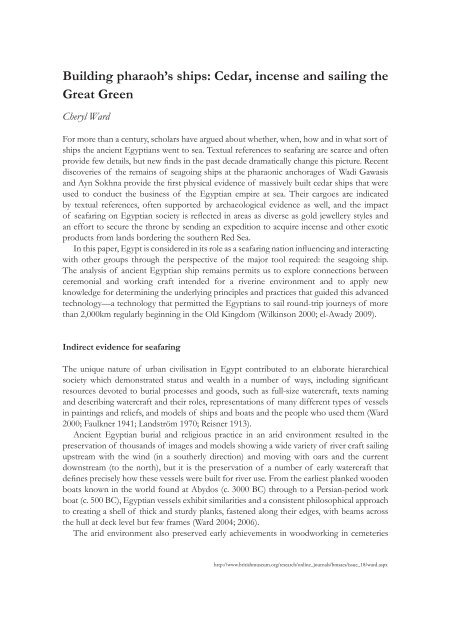Building pharaoh's ships: Cedar, incense and ... - British Museum
Building pharaoh's ships: Cedar, incense and ... - British Museum
Building pharaoh's ships: Cedar, incense and ... - British Museum
Create successful ePaper yourself
Turn your PDF publications into a flip-book with our unique Google optimized e-Paper software.
<strong>Building</strong> pharaoh’s <strong>ships</strong>: <strong>Cedar</strong>, <strong>incense</strong> <strong>and</strong> sailing the<br />
Great Green<br />
Cheryl Ward<br />
For more than a century, scholars have argued about whether, when, how <strong>and</strong> in what sort of<br />
<strong>ships</strong> the ancient Egyptians went to sea. Textual references to seafaring are scarce <strong>and</strong> often<br />
provide few details, but new finds in the past decade dramatically change this picture. Recent<br />
discoveries of the remains of seagoing <strong>ships</strong> at the pharaonic anchorages of Wadi Gawasis<br />
<strong>and</strong> Ayn Sokhna provide the first physical evidence of massively built cedar <strong>ships</strong> that were<br />
used to conduct the business of the Egyptian empire at sea. Their cargoes are indicated<br />
by textual references, often supported by archaeological evidence as well, <strong>and</strong> the impact<br />
of seafaring on Egyptian society is reflected in areas as diverse as gold jewellery styles <strong>and</strong><br />
an effort to secure the throne by sending an expedition to acquire <strong>incense</strong> <strong>and</strong> other exotic<br />
products from l<strong>and</strong>s bordering the southern Red Sea.<br />
In this paper, Egypt is considered in its role as a seafaring nation influencing <strong>and</strong> interacting<br />
with other groups through the perspective of the major tool required: the seagoing ship.<br />
The analysis of ancient Egyptian ship remains permits us to explore connections between<br />
ceremonial <strong>and</strong> working craft intended for a riverine environment <strong>and</strong> to apply new<br />
knowledge for determining the underlying principles <strong>and</strong> practices that guided this advanced<br />
technology—a technology that permitted the Egyptians to sail round-trip journeys of more<br />
than 2,000km regularly beginning in the Old Kingdom (Wilkinson 2000; el-Awady 2009).<br />
Indirect evidence for seafaring<br />
The unique nature of urban civilisation in Egypt contributed to an elaborate hierarchical<br />
society which demonstrated status <strong>and</strong> wealth in a number of ways, including significant<br />
resources devoted to burial processes <strong>and</strong> goods, such as full-size watercraft, texts naming<br />
<strong>and</strong> describing watercraft <strong>and</strong> their roles, representations of many different types of vessels<br />
in paintings <strong>and</strong> reliefs, <strong>and</strong> models of <strong>ships</strong> <strong>and</strong> boats <strong>and</strong> the people who used them (Ward<br />
2000; Faulkner 1941; L<strong>and</strong>ström 1970; Reisner 1913).<br />
Ancient Egyptian burial <strong>and</strong> religious practice in an arid environment resulted in the<br />
preservation of thous<strong>and</strong>s of images <strong>and</strong> models showing a wide variety of river craft sailing<br />
upstream with the wind (in a southerly direction) <strong>and</strong> moving with oars <strong>and</strong> the current<br />
downstream (to the north), but it is the preservation of a number of early watercraft that<br />
defines precisely how these vessels were built for river use. From the earliest planked wooden<br />
boats known in the world found at Abydos (c. 3000 BC) through to a Persian-period work<br />
boat (c. 500 BC), Egyptian vessels exhibit similarities <strong>and</strong> a consistent philosophical approach<br />
to creating a shell of thick <strong>and</strong> sturdy planks, fastened along their edges, with beams across<br />
the hull at deck level but few frames (Ward 2004; 2006).<br />
The arid environment also preserved early achievements in woodworking in cemeteries<br />
http://www.britishmuseum.org/research/online_journals/bmsaes/issue_18/ward.aspx
















